In this series we are exploring the weird and wonderful world of astronomy jargon! You’ll have to be careful around today’s topic: cosmic rays!
Continue reading “Astronomy Jargon 101: Cosmic Rays”Astronomy Jargon 101: Cosmic Rays


In this series we are exploring the weird and wonderful world of astronomy jargon! You’ll have to be careful around today’s topic: cosmic rays!
Continue reading “Astronomy Jargon 101: Cosmic Rays”Gamma rays strike Earth from all directions of the sky. Our planet is bathed in a diffuse glow of high-energy photons. It doesn’t affect us much, and we don’t really notice it, because our atmosphere is very good at absorbing gamma rays. It’s so good that we didn’t notice cosmic gamma rays until the 1960s when gamma-ray detectors were launched into space to look for signs of atomic weapons tests. Even then, what we noticed were intense flashes of gamma rays known as gamma ray bursts.
Continue reading “Finally an Answer to why Gamma Rays are Coming From Seemingly Empty Space”
So far we know of only two interstellar objects (ISO) to visit our Solar System. They are ‘Oumuamua and 2I/Borisov. There’s a third possible ISO named CNEOS 2014-01-08, and research suggests there should be many more.
But a new research letter shows that cosmic ray erosion limits the lifespan of icy ISOs, and though there may be many more of them, they simply don’t last as long as thought. If it’s true, then ‘Oumuamua was probably substantially larger when it started its journey, wherever that was.
Continue reading “Cosmic Rays Erode Away All But the Largest Interstellar Objects”
Roughly a century ago, scientists began to realize that some of the radiation we detect in Earth’s atmosphere is not local in origin. This eventually gave rise to the discovery of cosmic rays, high-energy protons and atomic nuclei that have been stripped of their electrons and accelerated to relativistic speeds (close to the speed of light). However, there are still several mysteries surrounding this strange (and potentially lethal) phenomenon.
This includes questions about their origins and how the main component of cosmic rays (protons) are accelerated to such high velocity. Thanks to new research led by the University of Nagoya, scientists have quantified the amount of cosmic rays produced in a supernova remnant for the first time. This research has helped resolve a 100-year mystery and is a major step towards determining precisely where cosmic rays come from.
Continue reading “Astronomers Locate the Source of High-Energy Cosmic Rays”
Using a new observatory, a team of Chinese astronomers have found over a dozen sources of ultra-high energy cosmic rays. And those sources aren’t from some distant, exotic corner of the cosmos. They come from our own backyard.
Continue reading “Astronomers Have Tracked Down the Source of High Energy Cosmic Rays to Regions Within the Milky Way Itself”
Walk into any modern hospital, and you’ll find a medical imaging department. Medical imaging uses x-rays, magnetic resonance imaging (MRI), and other arcane-sounding methods like positron emission tomography (PET) to image the body’s interior for analysis and diagnosis. To a non-specialist, these techniques can sound almost otherwordly. But in one way or another, these technologies rely on natural phenomena, including radiation, to do their thing.
Now a new study suggests that the Universe’s naturally occurring radiation could be used in medical imaging and could be particularly useful when it comes to COVID-19. The type of radiation in question is cosmic rays.
Continue reading “The Universe is Constantly Bathing you in Radiation. Incredibly, This Could be Used for Medical Diagnosis”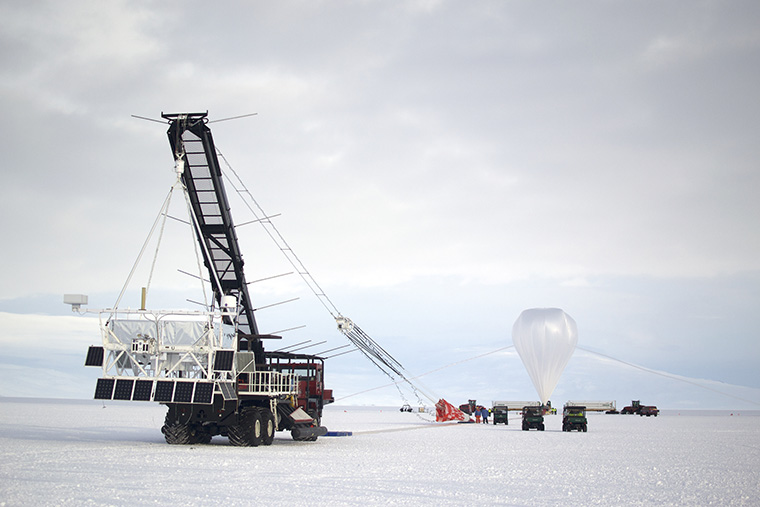
In 2012, the balloon-borne observatory known as the Super Trans-Iron Galactic Element Recorder (SuperTIGER) took to the skies to conduct high-altitude observations of Galactic Cosmic Rays (GCRs). Carrying on in the tradition of its predecessor (TIGER), SuperTiger set a new record after completing a 55-day flight over Antarctica – which happened between December of 2012 and January of 2013.
On December 16th, 2019, after multiple launch attempts, the observatory took to the air again and passed over Antarctica twice in the space of just three and a half weeks. Like its predecessor, SuperTIGER is a collaborative effort designed to study cosmic rays – high-energy protons and atomic nuclei – that originate outside of our Solar System and travel through space at close to the speed of light.
Continue reading “Balloon-Based Cosmic Ray Observatory is Now on its Second Trip Around Antarctica”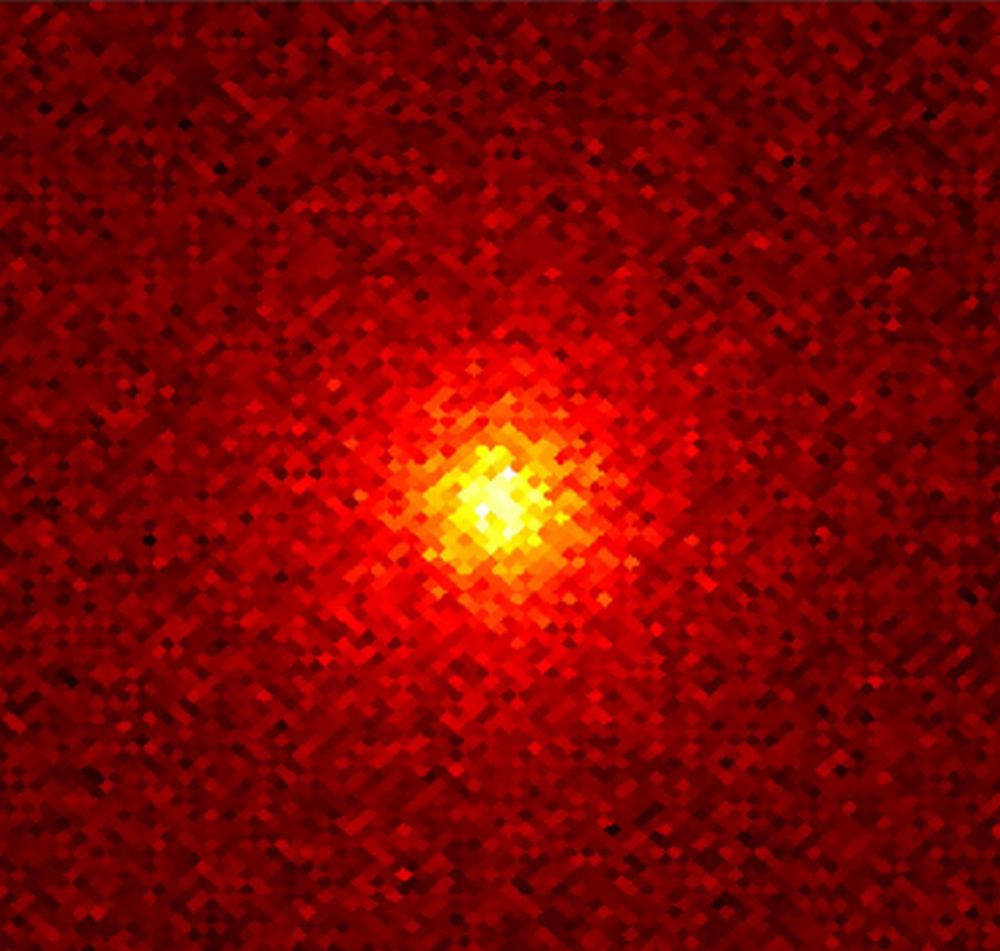
The eerie, hellish glow coming from the Moon may seem unreal in this image, since it’s invisible to our eyes. But instruments that detect gamma rays tell us it’s real. More than just a grainy, red picture, it’s a vivid reminder that there’s more going on than meets human eyes.
It’s also a reminder that any humans that visit the Moon need to be protected from this high-energy radiation.
Continue reading “When it Comes to Gamma Radiation, the Moon is Actually Brighter Than the Sun”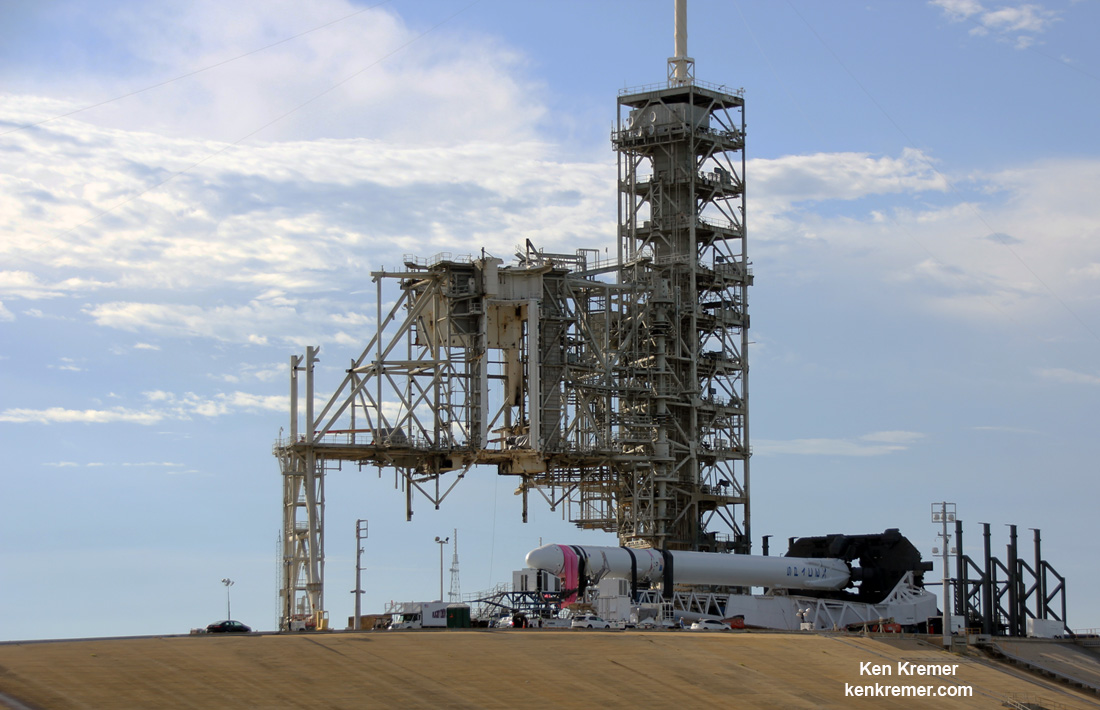

KENNEDY SPACE CENTER, FL – A triad of August liftoffs from the Florida Space Coast inaugurates Monday, Aug. 14 with a science laden commercial SpaceX Dragon bound for the International Space Station (ISS) – loaded with over 3 tons of NASA science, hardware and supplies including a cosmic ray detector, medical research experiments dealing with Parkinson’s disease and lung tissue, vegetable seeds, mice and much more, following a successful engine test firing of the Falcon 9 booster on Thursday.
“Static fire test of Falcon 9 complete,” SpaceX confirmed via Twitter soon after completion of the test at 9:10 a.m. EDT, Aug 10. (1310 GMT) “—targeting August 14 launch from Pad 39A for Dragon’s next resupply mission to the @Space_Station.”
Check out our photos & videos herein of the Aug. 10 static first test of the Falcon 9 first stage that paves the path to blastoff – as witnessed live by Ken Kremer and Jeff Seibert.
The triple headed sunshine state space spectacular kicks off with Monday’s lunchtime launch of the next unmanned SpaceX Dragon cargo freighter to the ISS from seaside pad 39A at NASA’s Kennedy Space Center in Florida, now targeted for Aug. 14 at 12:31 p.m. EDT (1631 GMT).
The closely spaced trio of space launches marches forward barely 4 days later with liftoff of NASA’s amazingly insectoid-looking TDRS-M science relay comsat slated for Friday morning Aug. 18 atop a United Launch Alliance (ULA) Atlas V rocket.
Lastly, a week after TDRS-M and just 11 days after the SpaceX Dragon an Orbital ATK Minotaur 4 rocket is due to blastoff just before midnight Aug. 25 and carry the ORS 5 mission to orbit for the U.S. military’s Operationally Responsive Space program. The Minotaur IV utilizes three stages from decommissioned Peacekeeper ICBMs formerly aimed at the Russians.
Of course getting 3 rockets off the ground from 3 different companies is all highly dependent on Florida’s hugely fickle hurricane season weather and the ever present reality of potential technical glitches, errant boaters and more – possibly resulting in a domino effect of cascading launch scrubs.
And sandwiched in between the Florida Space Coast blastoffs is the Total Solar ‘Eclipse Across America’ on Monday, Aug. 21 – for the first time in 99 years!
Although KSC and central Florida are not within the path of totality, the sun will still be about 85% obscured by the Moon.
So if you’re looking for bang for the space buck, the next two weeks have a lot to offer space and astronomy enthusiasts.

The Dragon resupply ship dubbed Dragon CRS-12 counts as SpaceX’s twelfth contracted commercial resupply services (CRS) mission to the International Space Station for NASA since 2012.

Watch this video of the Aug. 10 static hotfire test:
Video Caption: Hot fire test of the SpaceX Falcon 9 rocket in preparation for it launching the NASA CRS-12 Dragon resupply mission to the International Space Station from Pad 39A at Kennedy Space Center in Florida. Credit: Jeff Seibert/AmericaSpace
The 20-foot high, 12-foot-diameter Dragon CRS-12 vessel is carrying more than 6,400 pounds ( 2,900 kg) of science experiments and research instruments, crew supplies, food water, clothing, hardware, gear and spare parts to the million pound orbiting laboratory complex. 20 mice are also onboard. This will support dozens of the 250 research investigations and experiments being conducted by Expedition 52 and 53 crew members.
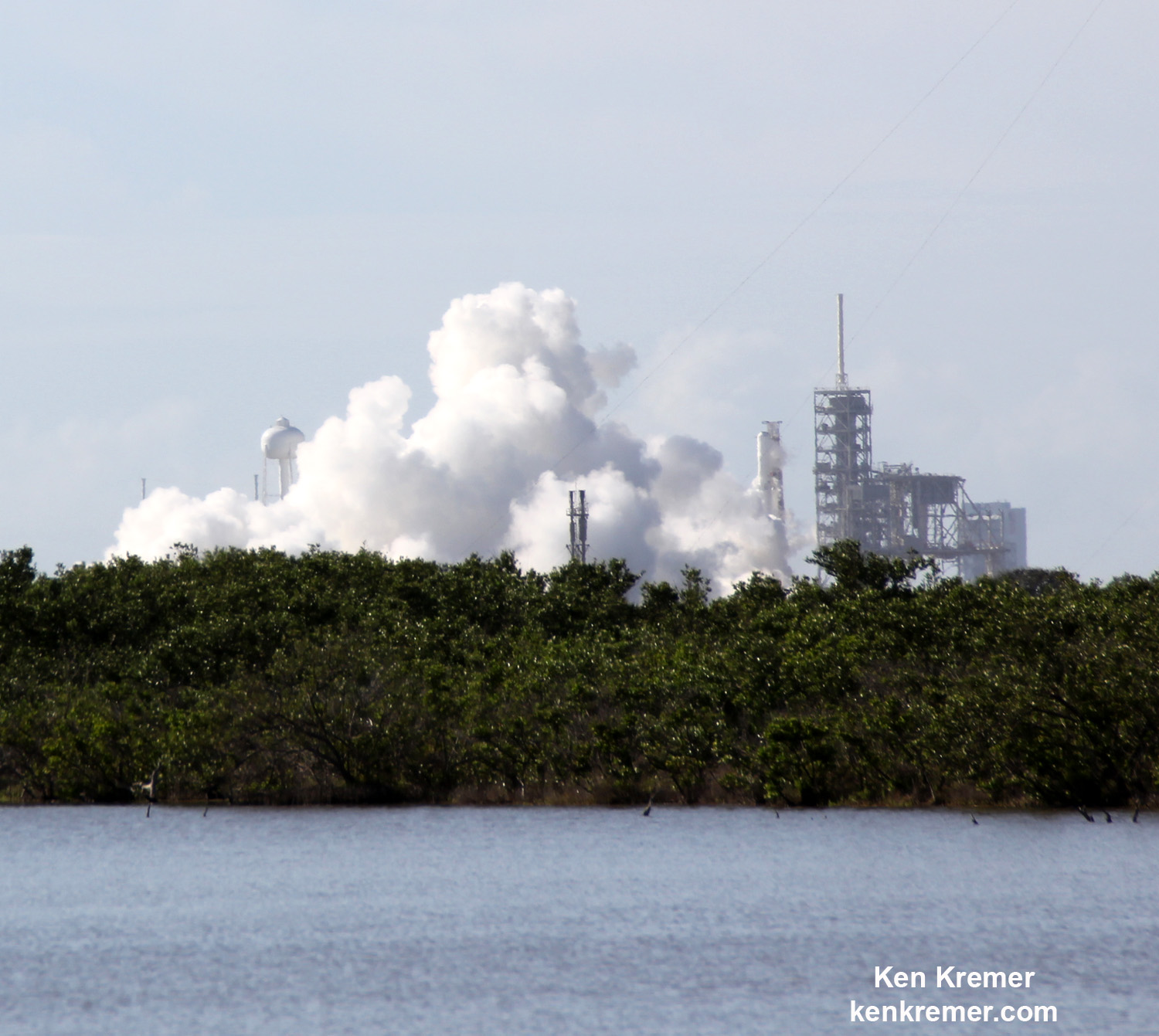
If you can’t personally be here to witness the launch in Florida, you can always watch NASA’s live coverage on NASA Television and the agency’s website.
The SpaceX/Dragon CRS-12 launch coverage will be broadcast on NASA TV beginning noon on Aug. 14 with additional commentary on the NASA launch blog.
SpaceX will also offer their own live webcast beginning approximately 15 minutes before launch at about 12:16 p.m. EDT.
You can watch the launch live at NASA TV at – http://www.nasa.gov/nasatv
You can also watch the launch live at SpaceX hosted Webcast at – spacex.com/webcast
In the event of delay for any reason, the next launch opportunity is Tuesday, Aug. 15 with NASA TV coverage starting about 11:30 a.m. EDT.
The weather looks decent at this time with a 70% chance of favorable conditions at launch time according to U.S. Air Force meteorologists with the 45th Space Wing Weather Squadron at Patrick Air Force Base. The primary concerns on Aug. 14 are cumulus clouds and the potential for precipitation in the flight path.
The odds remain at 70% favorable for the 24 hour scrub turnaround day on Aug. 15.
Everything is currently on track for Monday’s noontime launch of the 230 foot tall SpaceX Falcon 9 on the NASA contracted SpaceX CRS-12 resupply mission to the million pound orbiting lab complex.
However since the launch window is instantaneous there is no margin for error. In case any delays arise during the countdown due to technical or weather issues a 24 hour scrub to Tuesday will result.
The lunchtime launch coincidently offers a convenient and spectacular opportunity for fun for the whole family as space enthusiasts flock in from around the globe.
Plus SpaceX will attempt a land landing of the 156 foot tall first stage back at the Cape at Landing Zone 1 some 8 minutes after liftoff – thus a double whammy of space action !!– punctuated by multiple loud sonic booms at booster landing time that will figuratively knock your socks off.
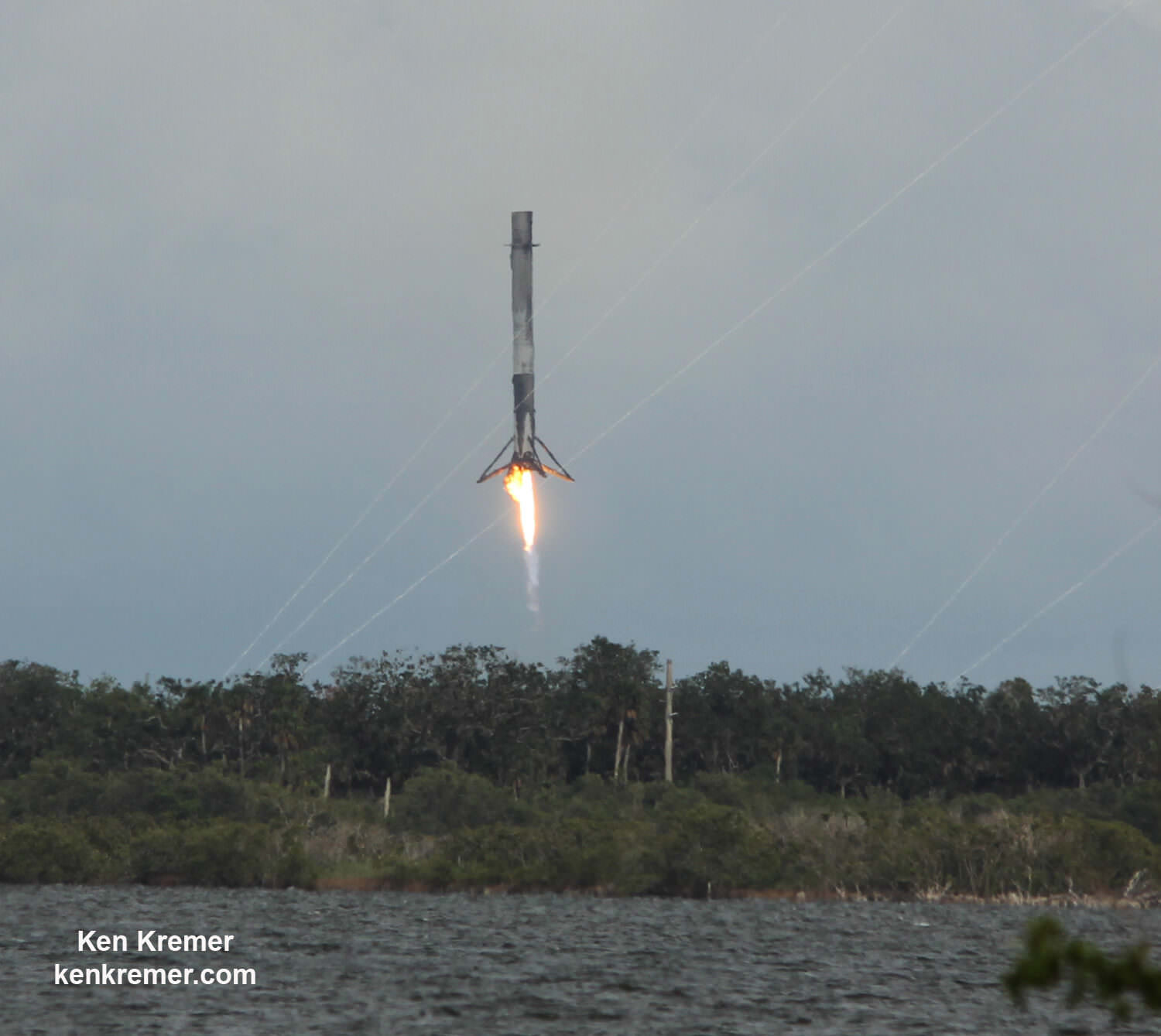
To date SpaceX has successfully recovered 13 boosters; 5 by land and 8 by sea, over the past 18 months. It’s a feat straight out of science fiction but aimed at drastically slashing the high cost of access to space.
The recent BulgariaSat-1 and Iridium-2 missions counted as the eighth and ninth SpaceX launches of 2017.
CRS-12 marks the eleventh SpaceX launch of 2017 and will establish a new single year record.
In contrast to the prior CRS-11 mission which flew a recycled Dragon, the CRS-12 Dragon is newly built.
The CRS-12 Dragon will be the last newly built one, says NASA. The remaining SpaceX CRS mission will utilize reused spaceships.
The Falcon 9 is also new and will attempt a land landing back at the Cape at Landing Zone-1 (LZ-1).
If the Aug. 14 launch occurs as scheduled, the Dragon will reach its preliminary orbit about 10 minutes later and deploy its life giving solar arrays. Dragon then begins a 2 day orbital chase of the station via a carefully choreographed series of thruster firings that bring the commercial spacecraft to rendezvous with the space station on Aug. 16.
Dragon will be grappled with the station’s Canadian built robotic arm at approximately 7 a.m. EDT on Aug. 16 by astronauts Jack Fischer of NASA and Paolo Nespoli of ESA (European Space Agency). It then will be installed on the Harmony module.
The Dragon spacecraft will spend approximately one month attached to the space station, returning to Earth in mid-September with results of earlier experiments.
Dragon CRS-12 is SpaceX’s third contracted resupply mission to launch this year for NASA.
The prior SpaceX cargo ships launched on Feb 19 and June 3, 2017 on the CRS-10 and CRS-11 missions to the space station. CRS-10 is further noteworthy as being the first SpaceX launch of a Falcon 9 from NASA’s historic pad 39A.
SpaceX leased pad 39A from NASA in 2014 and after refurbishments placed the pad back in service this year for the first time since the retirement of the space shuttles in 2011.
Previous launches include 11 Apollo flights, the launch of the unmanned Skylab in 1973, 82 shuttle flights and five SpaceX launches.
Cargo Manifest for CRS-12:
TOTAL CARGO: 6415.4 lbs. / 2910 kg
TOTAL PRESSURIZED CARGO WITH PACKAGING: 3642 lbs. / 1652 kg
• Science Investigations 2019.4 lbs. / 916 kg
• Crew Supplies 485 lbs. / 220 kg
• Vehicle Hardware 747.4 lbs. / 339 kg
• Spacewalk Equipment 66.1 lbs. / 30 kg
• Computer Resources 116.8 lbs. / 53 kg
UNPRESSURIZED 2773.4 lbs. / 1258 kg
• Cosmic-Ray Energetics and Mass (CREAM) 2773.4 lbs. / 1258 kg
The CREAM instrument from the University of Maryland will be stowed for launch inside the Dragon’s unpressurized trunk. Astronauts will use the stations robotic arm to pluck it from the trunk and attach it to the exposed porch of the Japanese Experiment Module (JEM).

Here is a NASA description of CREAM:
The Cosmic Ray Energetics and Mass (CREAM) instrument, attached to the Japanese Experiment Module Exposed Facility, measures the charges of cosmic rays ranging from hydrogen to iron nuclei. The data collected from the CREAM instrument will be used to address fundamental science questions on the origins and history of cosmic rays. CREAM’s three-year mission will help the scientific community build a stronger understanding of the fundamental structure of the universe.
The LRRK2 experiment seeks to grow larger crystals of the protein to investigate Parkinson’s disease and help develop new therapies:
Here is a NASA description of LRRK2:
Crystallization of Leucine-rich repeat kinase 2 (LRRK2) under Microgravity Conditions (CASIS PCG 7) will use the orbiting laboratory’s microgravity environment to grow larger versions of this important protein, implicated in Parkinson’s disease. Developed by the Michael J. Fox Foundation, Anatrace and Com-Pac International, researchers will look to take advantage of the station’s microgravity environment which allows protein crystals to grow larger and in more perfect shapes than earth-grown crystals, allowing them to be better analyzed on Earth. Defining the exact shape and morphology of LRRK2 would help scientists to better understand the pathology of Parkinson’s and aid in the development of therapies against this target.
Watch this Michael J. Fox video describing the LRRK2 crystallization experiment:
Video Caption: ISS National Lab SpaceX CRS-12 Payload Overview: Michael J. Fox Foundation. The Michael J. Fox Foundation is sending an experiment to the ISS National Lab to investigate the LRRK2 protein, a key target in identifying the makeup of Parkinson’s disease.
Watch for Ken’s continuing onsite CRS-12, TRDS-M, and ORS 5 and NASA mission reports direct from the Kennedy Space Center and Cape Canaveral Air Force Station, Florida.
Stay tuned here for Ken’s continuing Earth and Planetary science and human spaceflight news.
………….
Learn more about the upcoming SpaceX Dragon CRS-12 resupply launch to ISS on Aug. 14, ULA Atlas TDRS-M NASA comsat on Aug. 18, 2017 Solar Eclipse, NASA missions and more at Ken’s upcoming outreach events at Kennedy Space Center Quality Inn, Titusville, FL:
Aug 12-14: “SpaceX CRS-12 resupply launches to the ISS, Intelsat35e, BulgariaSat 1 and NRO Spysat, SLS, Orion, Commercial crew capsules from Boeing and SpaceX , Heroes and Legends at KSCVC, ULA Atlas/John Glenn Cygnus launch to ISS, SBIRS GEO 3 launch, GOES-R weather satellite launch, OSIRIS-Rex, Juno at Jupiter, InSight Mars lander, SpaceX and Orbital ATK cargo missions to the ISS, ULA Delta 4 Heavy spy satellite, Curiosity and Opportunity explore Mars, Pluto and more,” Kennedy Space Center Quality Inn, Titusville, FL, evenings
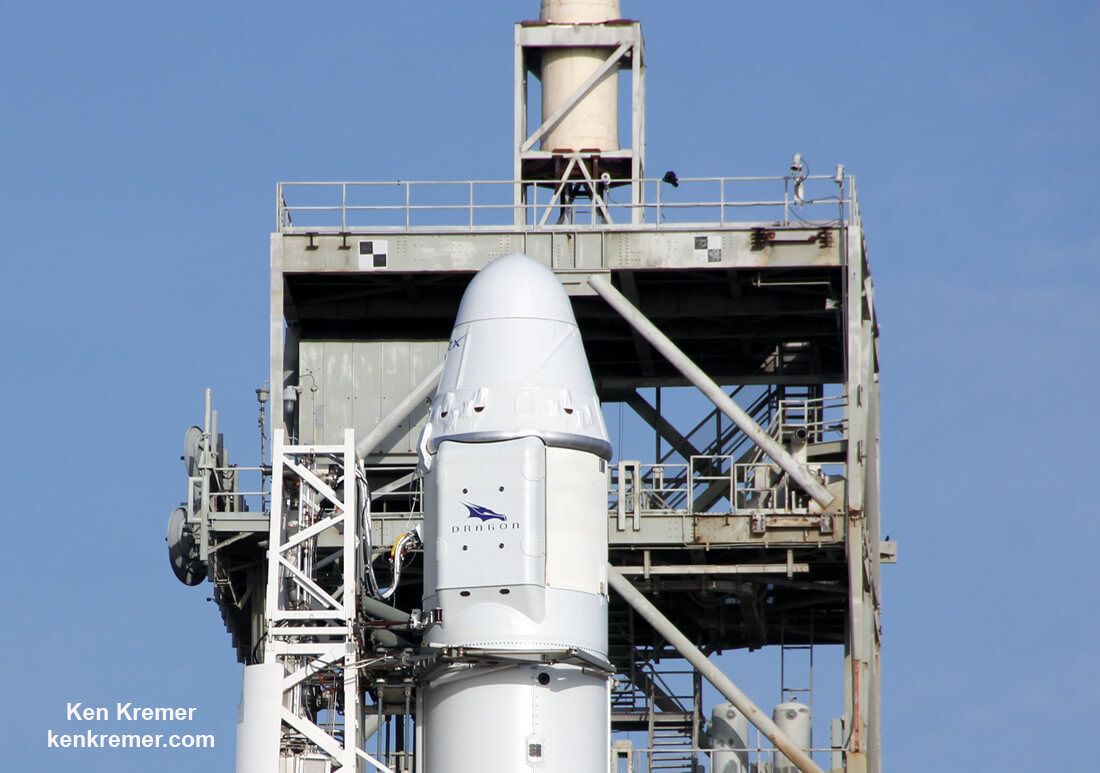
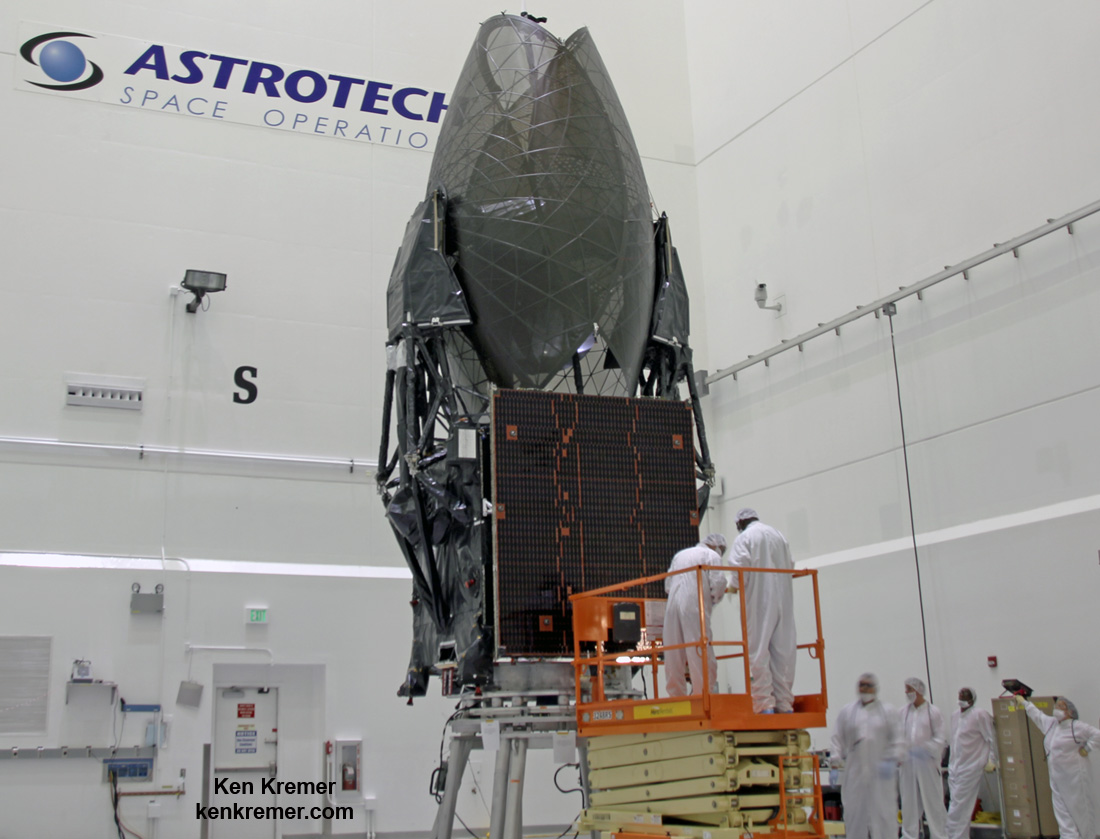

Astronauts hoping to take part in a crewed mission to Mars might want to pack some additional rad tablets! Long before NASA announced their proposal for a “Journey to Mars“, which envisions putting boots on the Red Planet by the 2030s, mission planners have been aware that one of the greatest risks for such a mission has to do with the threat posed by cosmic and solar radiation.
But according to a new study from the University of Nevada, Las Vegas, this threat is even worse than previously thought. Using a predictive model, this study indicates that astronauts that are the surface of Mars for extended periods of time could experience cell damage from cosmic rays, and that this damage will extend to other healthy cells – effectively doubling the risk of cancer!
The study, which was led by UNLV scientist Dr. Francis Cucinotta, was published in the May issue of Scientific Reports – under the title of “Non-Targeted Effects Models Predict Significantly Higher Mars Mission Cancer Risk than Targeted Effects Models“. Building on conventional models that predict that DNA damage caused by radiation leads to cancer, their model looked at how such damage could spread throughout the body.
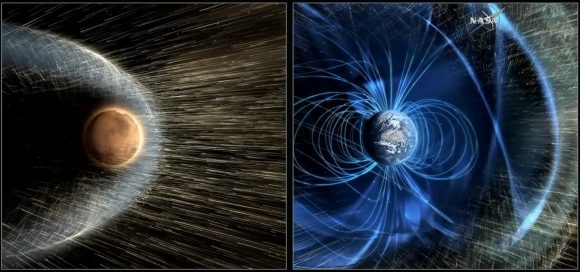
Galactic cosmic rays (GCRs) are one of the greatest hazards posed by space exploration. These particles, which originate from beyond our Solar System, are basically atomic nuclei that have been stripped of their surrounding electrons, thanks to their high-speed journey through space. In the cases of iron and titanium atoms, these have been known to cause heavy damage to cells because of their very high rates of ionization.
Here on Earth, we are protected from these rays and other sources of radiation thanks to our protective magnetosphere. But with missions that would take astronauts well beyond Earth, they become a much greater threat. And given the long-term nature of a mission to Mars, mitigation procedures and shielding are being investigated quite thoroughly. As Cucinotta explained in a UNLV press statement:
“Exploring Mars will require missions of 900 days or longer and includes more than one year in deep space where exposures to all energies of galactic cosmic ray heavy ions are unavoidable. Current levels of radiation shielding would, at best, modestly decrease the exposure risks.”
Previous studies have indicated that the effects of prolonged exposure to cosmic rays include cancer, central nervous system effects, cataracts, circulatory diseases and acute radiation syndromes. However, until now, the damage these rays cause was thought to be confined to those cells that they actually traverse – which was based on models that deal with the targeted effects of radiation.

For the sake of their study, Dr. Cucinotta and Dr. Eliedonna Cacao (a Chemical Engineer at UNLV) consulted the mouse Harderian gland tumor experiment. This is the only extensive data-set to date that deals with the non-targeted effects (NTEs) of radiation for a variety of particles. Using this model, they tracked the effects of chronic exposure to GCRs, and determined that the risks would be twice as high as those predicted by targeted effects models.
“Galactic cosmic ray exposure can devastate a cell’s nucleus and cause mutations that can result in cancers,” Cucinotta explained. “We learned the damaged cells send signals to the surrounding, unaffected cells and likely modify the tissues’ microenvironments. Those signals seem to inspire the healthy cells to mutate, thereby causing additional tumors or cancers.”
Naturally, any indication that there could be an elevated risk calls for additional research. As Cucinotta and Cacao indicated in their study, “The scarcity of data with animal models for tissues that dominate human radiation cancer risk, including lung, colon, breast, liver, and stomach, suggest that studies of NTEs in other tissues are urgently needed prior to long-term space missions outside the protection of the Earth’s geomagnetic sphere.”
These studies will of course need to happen before any long-term space missions are mounted beyond Earth’s magnetosphere. In addition, the findings also raise undeniable ethical issues, such as whether or not these risks could (or should) be waived by space agencies and astronauts. If in fact we cannot mitigate or protect against the hazards associated with long-term missions, is it even right to ask or allow astronauts to take part in them?
In the meantime, NASA may want to have another look at the mission components for the Journey to Mars, and maybe contemplate adding an additional layer or two of lead shielding. Better to be prepared for the worst, right?